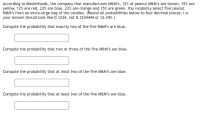
MATLAB: An Introduction with Applications
6th Edition
ISBN: 9781119256830
Author: Amos Gilat
Publisher: John Wiley & Sons Inc
expand_more
expand_more
format_list_bulleted
Concept explainers
Topic Video
Question
According to Masterfoods, the company that manufactures M&M’s, 12% of peanut M&M’s are brown, 15% are yellow, 12% are red, 23% are blue, 23% are orange and 15% are green. You randomly select five peanut M&M’s from an extra-large bag of the candies. (Round all probabilities below to four decimal places; i.e. your answer should look like 0.1234, not 0.1234444 or 12.34%.)
(a) Compute the probability that exactly two of the five M&M’s are blue.
(b) Compute the probability that two or three of the five M&M’s are blue.
(c) Compute the probability that at most two of the five M&M’s are blue.
(d) Compute the probability that at least two of the five M&M’s are blue.

Expert Solution
This question has been solved!
Explore an expertly crafted, step-by-step solution for a thorough understanding of key concepts.
This is a popular solution
Trending nowThis is a popular solution!
Step by stepSolved in 4 steps with 4 images

Knowledge Booster
Learn more about
Need a deep-dive on the concept behind this application? Look no further. Learn more about this topic, statistics and related others by exploring similar questions and additional content below.Similar questions
- A firm making production plans believes there is a 30% probability the price will be $10, a 50% probability the price will be $15, and a 20% probability the price will be $20. The manager must decide whether to produce 6,000 units of output (A), 8,000 units (B) or 10,000 units (C). The following table shows 9 possible outcomes depending on the output chosen and the actual price. Production Profit (Loss) when price is $10 $15 $20 6,000 (A) −$200 $400 $1,000 8,000 (B) −$400 $600 $1,600 10,000 (C) −$1,000 $800 $3,000 What is the variance if 6,000 units are produced?arrow_forwardYou hold an oral, or English, auction among three bidders. You estimate that each bidder has a value of either $48 or $60 for the item, and you attach probabilities to each value of 50%. The winning bidder must pay a price equal to the second highest bid. The following table lists the eight possible combinations for bidder values. Each combination is equally likely to occur. On the following table, indicate the price paid by the winning bidder. Bidder 1 Value Bidder 2 Value Bidder 3 Value Probability Price ($) ($) ($) $48 $48 $48 0.125 $48 $48 $60 0.125 $48 $60 $48 0.125 $48 $60 $60 0.125 $60 $48 $48 0.125 $60 $48 $60 0.125 $60 $60 $48 0.125 $60 $60 $60 0.125 The expected price paid is ______ . Suppose that bidders 1 and 2 collude and would be willing to bid up to a maximum of their values, but the two bidders would not be willing to bid against each other. The probabilities of the…arrow_forwardIf the probability that the Islanders will beat the Rangers in a game is 81%, what is the probability that the Islanders will win at least three out of five games in a series against the Rangers? Round your answer to the nearest thousandth.arrow_forward
Recommended textbooks for you
 MATLAB: An Introduction with ApplicationsStatisticsISBN:9781119256830Author:Amos GilatPublisher:John Wiley & Sons Inc
MATLAB: An Introduction with ApplicationsStatisticsISBN:9781119256830Author:Amos GilatPublisher:John Wiley & Sons Inc Probability and Statistics for Engineering and th...StatisticsISBN:9781305251809Author:Jay L. DevorePublisher:Cengage Learning
Probability and Statistics for Engineering and th...StatisticsISBN:9781305251809Author:Jay L. DevorePublisher:Cengage Learning Statistics for The Behavioral Sciences (MindTap C...StatisticsISBN:9781305504912Author:Frederick J Gravetter, Larry B. WallnauPublisher:Cengage Learning
Statistics for The Behavioral Sciences (MindTap C...StatisticsISBN:9781305504912Author:Frederick J Gravetter, Larry B. WallnauPublisher:Cengage Learning Elementary Statistics: Picturing the World (7th E...StatisticsISBN:9780134683416Author:Ron Larson, Betsy FarberPublisher:PEARSON
Elementary Statistics: Picturing the World (7th E...StatisticsISBN:9780134683416Author:Ron Larson, Betsy FarberPublisher:PEARSON The Basic Practice of StatisticsStatisticsISBN:9781319042578Author:David S. Moore, William I. Notz, Michael A. FlignerPublisher:W. H. Freeman
The Basic Practice of StatisticsStatisticsISBN:9781319042578Author:David S. Moore, William I. Notz, Michael A. FlignerPublisher:W. H. Freeman Introduction to the Practice of StatisticsStatisticsISBN:9781319013387Author:David S. Moore, George P. McCabe, Bruce A. CraigPublisher:W. H. Freeman
Introduction to the Practice of StatisticsStatisticsISBN:9781319013387Author:David S. Moore, George P. McCabe, Bruce A. CraigPublisher:W. H. Freeman

MATLAB: An Introduction with Applications
Statistics
ISBN:9781119256830
Author:Amos Gilat
Publisher:John Wiley & Sons Inc

Probability and Statistics for Engineering and th...
Statistics
ISBN:9781305251809
Author:Jay L. Devore
Publisher:Cengage Learning

Statistics for The Behavioral Sciences (MindTap C...
Statistics
ISBN:9781305504912
Author:Frederick J Gravetter, Larry B. Wallnau
Publisher:Cengage Learning

Elementary Statistics: Picturing the World (7th E...
Statistics
ISBN:9780134683416
Author:Ron Larson, Betsy Farber
Publisher:PEARSON

The Basic Practice of Statistics
Statistics
ISBN:9781319042578
Author:David S. Moore, William I. Notz, Michael A. Fligner
Publisher:W. H. Freeman

Introduction to the Practice of Statistics
Statistics
ISBN:9781319013387
Author:David S. Moore, George P. McCabe, Bruce A. Craig
Publisher:W. H. Freeman